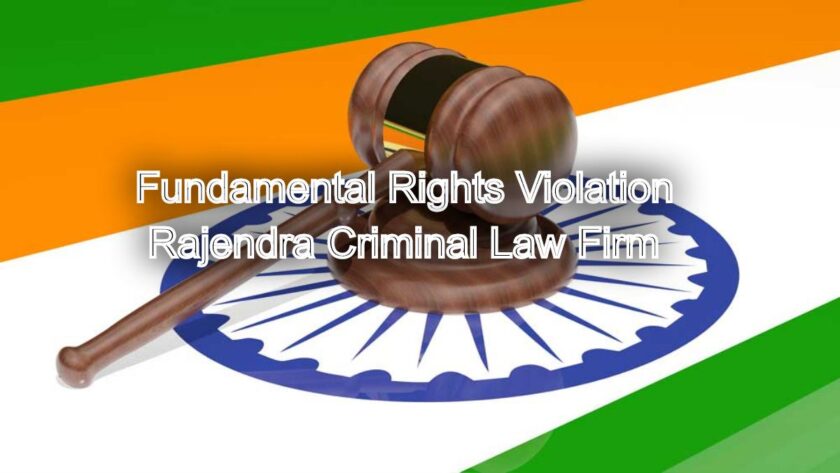Can You Approach the Supreme Court Directly? Fundamental Rights are the bedrock of India’s democracy. They guarantee essential liberties to every citizen. These rights are enshrined in Part III of the Indian Constitution. They include the right to equality, freedom of speech, and protection of life and personal liberty. However, violations of these crucial rights can occur. When such violations happen, citizens often feel powerless. They seek immediate redressal. Many wonder if they can directly approach the highest court in the land. The answer is indeed yes. This article explores the provisions allowing direct access to the Supreme Court. It explains the legal framework and its implications. Rajendra Criminal Law Firm provides expert legal assistance. We safeguard your fundamental rights rigorously.
Can You Approach the Supreme Court Directly for Fundamental Rights Violation?- Rajendra Criminal Law Firm
The Significance of Fundamental Rights in India
Fundamental Rights are not mere legal provisions. They are foundational to human dignity and freedom. Act as limitations on state power. They prevent governmental overreach. For instance, Article 14 guarantees equality before the law. Article 19 protects various freedoms, including speech and expression. Article 21 safeguards the right to life and personal liberty. These rights are often called the “conscience of the Constitution.” They are non-negotiable. They are enforceable by law.
Furthermore, they are available against the State. This includes the government, Parliament, state legislatures, and local authorities. They are also available against public sector undertakings. Some fundamental rights are even enforceable against private individuals. For example, the abolition of untouchability (Article 17). Therefore, their violation demands urgent and effective remedies. The Constitution itself provides specific mechanisms for their enforcement. This makes these rights truly powerful.
The Power of the Supreme Court: Article 32
The Indian Constitution provides a unique and powerful remedy for fundamental rights violations. This is enshrined in Article 32. It explicitly grants individuals the right to move the Supreme Court directly. This is not merely a procedural right. Article 32 itself is a Fundamental Right. It guarantees the right to constitutional remedies. Therefore, it makes the Supreme Court the guarantor and protector of Fundamental Rights. This provision is often considered the “heart and soul” of the Constitution. It provides extraordinary jurisdiction to the Supreme Court.
Under Article 32, the Supreme Court can issue various writs. These are powerful judicial orders. They compel authorities to act or restrain them from acting. The primary writs include:
- Habeas Corpus: This writ is issued to produce a person who has been illegally detained. It ensures that no one is unlawfully imprisoned.
- Mandamus: This writ commands a public official or body to perform a duty. This duty must be of a public nature.
- Prohibition: This writ prevents a lower court or tribunal from exceeding its jurisdiction.
- Certiorari: This writ quashes an order passed by a lower court or tribunal. This order must be beyond its jurisdiction or an error of law.
- Quo Warranto: This writ questions the legality of a person holding a public office. It checks usurpation of public office.
The Supreme Court uses these writs to enforce fundamental rights effectively. This direct access mechanism ensures swift justice. It prevents prolonged violations.
Concurrent Jurisdiction: High Courts and Article 226
While Article 32 offers direct access to the Supreme Court, it is not the only avenue. Article 226 of the Constitution grants similar writ jurisdiction to the High Courts. Every High Court in India can issue the same five writs. They can do so for the enforcement of fundamental rights. They can also do so for “any other purpose.” This broader scope allows High Courts to grant relief even for violations of ordinary legal rights.
This creates concurrent jurisdiction for fundamental rights enforcement. Both the Supreme Court and the High Courts have the power to hear such cases. Consequently, individuals have a choice of forum. They can approach either court. However, the Supreme Court generally prefers that individuals first approach the High Court. This policy is based on judicial discipline. It encourages utilizing the lower court’s remedies first. Nevertheless, in cases of grave urgency or widespread violations, direct Supreme Court intervention is not precluded. The choice often depends on the specific facts and urgency of the situation.
When to Approach the Supreme Court Directly
Although concurrent jurisdiction exists, direct approach to the Supreme Court under Article 32 is typically reserved for specific situations. The Supreme Court usually encourages exhausting remedies at the High Court level first. However, there are instances where direct access is considered appropriate.
Firstly, cases involving widespread violations of fundamental rights are often accepted directly. For example, issues affecting a large segment of society. Secondly, matters of national importance frequently warrant direct Supreme Court intervention. These involve constitutional questions with far-reaching implications. Thirdly, if a High Court has itself violated fundamental rights, direct access becomes necessary. Lastly, in situations of extreme urgency or when no other effective remedy exists, the Supreme Court might entertain a direct petition. Such cases often involve grave personal liberty infringements. Therefore, the decision to approach directly requires careful legal analysis. It demands consideration of strategic advantages.
The Petition Process at the Supreme Court
Filing a petition under Article 32 at the Supreme Court involves specific legal procedures. The aggrieved individual, or their legal counsel, drafts a Writ Petition. This document meticulously outlines the facts. It specifies the fundamental right violated. Clearly states the relief sought. It must be supported by an affidavit. This sworn statement authenticates the facts presented.
Subsequently, the petition is filed with the Supreme Court Registry. It undergoes a scrutiny process. This ensures compliance with court rules. The court then lists the petition for preliminary hearing. During this hearing, the judges decide whether to admit the petition. They assess its prima facie merit. If admitted, the court issues notice to the respondents (the parties against whom the relief is sought). These respondents then file their counter-affidavits. The petitioner may then file a rejoinder. The case proceeds to final hearing. Both sides present their arguments. The Supreme Court then delivers its judgment. This judgment is binding on all courts below it. It establishes crucial legal precedents.
Strategic Considerations for Direct Approach
Approaching the Supreme Court directly requires careful strategic planning. It is not a routine step. The legal team must assess several factors. Firstly, the urgency of the matter is critical. Is there an immediate threat to life or liberty? Secondly, the nature of the violation must be clearly established. Is it indeed a fundamental rights violation? Thirdly, the complexity of facts and law plays a role. Is the issue purely legal or does it involve extensive factual disputes?
Furthermore, the precedential value of the case can be a factor. Does the case raise an important constitutional question? The financial implications must also be considered. Supreme Court litigation can be expensive. Therefore, a thorough cost-benefit analysis is crucial. Rajendra Criminal Law Firm offers expert strategic advice. We help clients weigh these considerations. We determine the most effective legal path. Our experience at the highest levels of the judiciary ensures optimal representation.
Limitations and Practicalities
While Article 32 is a powerful remedy, it has certain limitations in practice. The Supreme Court may decline to hear a petition if an effective alternative remedy exists. This often means advising the petitioner to approach the High Court first. The court may also dismiss petitions that are frivolous or lack merit. Furthermore, direct approach under Article 32 is solely for fundamental rights violations. It cannot be invoked for mere violations of ordinary legal rights. For those, recourse must be sought through other legal channels.
Moreover, the sheer volume of cases before the Supreme Court can lead to delays. Even urgent matters can take time. Therefore, managing client expectations is crucial. The quality of legal representation is paramount. A well-prepared petition and strong arguments are essential for success. Rajendra Criminal Law Firm understands these practicalities. We prepare our cases meticulously. Navigate the Supreme Court’s procedures effectively. We strive for timely and favorable outcomes for our clients.
Frequently Asked Questions
A: Yes, absolutely. Article 32 of the Indian Constitution grants every individual the explicit right to move the Supreme Court directly for the enforcement of their Fundamental Rights. This Article itself is a Fundamental Right, making the Supreme Court the guarantor and protector of these rights.
A: Under Article 32, the Supreme Court can issue various powerful judicial orders known as writs. These include Habeas Corpus (for illegal detention), Mandamus (to compel public duty), Prohibition (to stop lower courts from exceeding jurisdiction), Certiorari (to quash erroneous orders of lower courts), and Quo Warranto (to question the legality of holding public office).
A: Yes, High Courts also have the power to protect Fundamental Rights under Article 226 of the Constitution. This creates concurrent jurisdiction with the Supreme Court. High Courts can issue the same writs as the Supreme Court, and also for “any other purpose,” making their jurisdiction broader for general legal rights.
A: The Supreme Court generally prefers individuals to approach the High Court first. However, it may hear a petition directly in cases involving widespread violations of fundamental rights, matters of national importance, situations where a High Court has itself violated fundamental rights, or in instances of extreme urgency with no other effective remedy.
A: The first step is to draft a meticulous Writ Petition. This document must clearly state the facts of the violation, identify the specific Fundamental Right infringed, and explicitly state the relief sought. This petition must then be supported by a sworn affidavit and filed with the Supreme Court Registry.
Conclusion
Fundamental Rights are the very essence of a free society. Their protection is a constitutional imperative. The Indian Constitution provides a direct and potent remedy for their violation through Article 32. This unique provision allows citizens to approach the Supreme Court directly. It makes the Supreme Court the ultimate guardian of these invaluable rights.
While High Courts also possess concurrent jurisdiction under Article 226, direct Supreme Court intervention is reserved for grave or urgent matters. Understanding when and how to invoke this extraordinary jurisdiction is critical. It demands deep legal knowledge and strategic foresight. Rajendra Criminal Law Firm stands as a pillar of strength. We are dedicated to defending your fundamental rights with unwavering commitment. Our expertise ensures rigorous representation. We protect your liberties. We uphold justice. Contact us today. Secure the powerful legal defense you need.
Read More
- Supreme Court Guidelines on Arrests and Bail: What Every Accused Must Know
- How to File a Special Leave Petition (SLP) in the Supreme Court – Step by Step Guide
- Mastering Commercial Contracts: Legal Insights for Modern Businesses
- Curative Petition in Supreme Court: Last Hope After Dismissal of Review
- Steps to File Complaints Against Tamil Nadu State Electricity Board (TNEB) Officers
- Supreme Court of India





